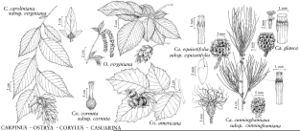Difference between revisions of "Casuarina glauca"
Syst. Veg. 3: 803. 1826.
FNA>Volume Importer |
FNA>Volume Importer |
||
| Line 27: | Line 27: | ||
}}<!-- | }}<!-- | ||
| − | --><span class="statement" id="st- | + | --><span class="statement" id="st-undefined" data-properties=""><b>Trees,</b> 8-20 m, frequently producing root suckers. <b>Bark</b> gray-brown, finely fissured and scaly. <b>Branchlets</b> drooping; segments 8-20 × 0.9-1.2 mm, glabrous, occasionally waxy; longitudinal ridges flat to slightly rounded-convex; teeth usually marcescent, 12-17, erect, 0.6-0.9 mm. <b>Young</b> permanent shoots with long-recurved teeth. <b>Flowers</b> unisexual, staminate and pistillate on different plants. <b>Staminate</b> spikes 1.2-4 cm, 7-10 whorls per cm; anthers ca. 0.8 mm. <b>Infructescences</b> rust-colored to white-pubescent, becoming glabrous; peduncles 3-12 mm; infructescence body 9-18 × 7-9 mm; bracteoles broadly acute. <b>Samaras</b> 3.5-5 mm.</span><!-- |
-->{{Treatment/Body | -->{{Treatment/Body | ||
|habitat=Commonly near brackish water | |habitat=Commonly near brackish water | ||
|elevation=0-50 m | |elevation=0-50 m | ||
| − | |distribution=Fla.;native;e coast Australia | + | |distribution=Fla.;native;e coast Australia. |
|discussion=<p>Commonly near brackish water; 0-50 m; introduced; Fla.; native, e coast Australia.</p><!-- | |discussion=<p>Commonly near brackish water; 0-50 m; introduced; Fla.; native, e coast Australia.</p><!-- | ||
--><p>Casuarina glauca is widely cultivated in many parts of the world. Pistillate trees are very infrequent in the flora.</p><!-- | --><p>Casuarina glauca is widely cultivated in many parts of the world. Pistillate trees are very infrequent in the flora.</p><!-- | ||
| Line 53: | Line 53: | ||
|habitat=Commonly near brackish water | |habitat=Commonly near brackish water | ||
|elevation=0-50 m | |elevation=0-50 m | ||
| − | |distribution=Fla.;native;e coast Australia | + | |distribution=Fla.;native;e coast Australia. |
|introduced=true | |introduced=true | ||
|reference=None | |reference=None | ||
| Line 59: | Line 59: | ||
|publication year=1826 | |publication year=1826 | ||
|special status=Selected by author to be illustrated;Weedy;Introduced | |special status=Selected by author to be illustrated;Weedy;Introduced | ||
| − | |source xml=https://jpend@bitbucket.org/aafc-mbb/fna- | + | |source xml=https://jpend@bitbucket.org/aafc-mbb/fna-data-curation.git/src/9216fc802291cd3df363fd52122300479582ede7/coarse_grained_fna_xml/V3/V3_1138.xml |
|genus=Casuarina | |genus=Casuarina | ||
|species=Casuarina glauca | |species=Casuarina glauca | ||
| − | |||
| − | |||
| − | |||
| − | |||
| − | |||
| − | |||
| − | |||
| − | |||
| − | |||
| − | |||
| − | |||
| − | |||
| − | |||
| − | |||
| − | |||
| − | |||
| − | |||
| − | |||
| − | |||
| − | |||
| − | |||
| − | |||
| − | |||
| − | |||
| − | |||
| − | |||
| − | |||
| − | |||
| − | |||
| − | |||
}}<!-- | }}<!-- | ||
-->[[Category:Treatment]][[Category:Casuarina]] | -->[[Category:Treatment]][[Category:Casuarina]] | ||
Revision as of 14:32, 27 July 2019
Trees, 8-20 m, frequently producing root suckers. Bark gray-brown, finely fissured and scaly. Branchlets drooping; segments 8-20 × 0.9-1.2 mm, glabrous, occasionally waxy; longitudinal ridges flat to slightly rounded-convex; teeth usually marcescent, 12-17, erect, 0.6-0.9 mm. Young permanent shoots with long-recurved teeth. Flowers unisexual, staminate and pistillate on different plants. Staminate spikes 1.2-4 cm, 7-10 whorls per cm; anthers ca. 0.8 mm. Infructescences rust-colored to white-pubescent, becoming glabrous; peduncles 3-12 mm; infructescence body 9-18 × 7-9 mm; bracteoles broadly acute. Samaras 3.5-5 mm.
Habitat: Commonly near brackish water
Elevation: 0-50 m
Distribution

Fla., native, e coast Australia.
Discussion
Commonly near brackish water; 0-50 m; introduced; Fla.; native, e coast Australia.
Casuarina glauca is widely cultivated in many parts of the world. Pistillate trees are very infrequent in the flora.
It is now considered a pest species in Florida because of root suckering. Its identification may be confused by the practice of some Florida nurserymen of grafting scions of Casuarina glauca onto rootstocks from the other two species.
Selected References
None.
